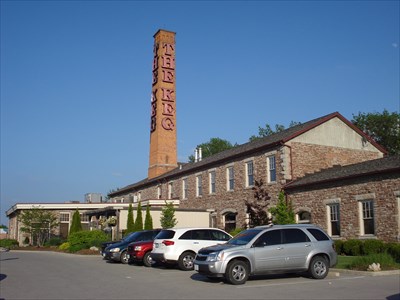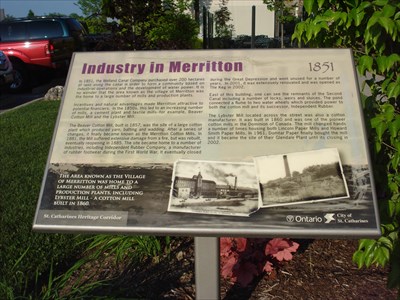
Merritton Cotton Mill - St. Catharines, Ontario, Canada
N 43° 08.135 W 079° 12.908
17T E 645162 N 4777417
The area known as the village of Merritton was home to a large number of mills and production plants, including the Beaver Cotton Mill later known as the Merritton Cotton Mills.
Waymark Code: WM8XAN
Location: Ontario, Canada
Date Posted: 05/25/2010
Views: 11

Merritton Cotton Mill
The Old Meritton Mill was a part of the 19th century boom of technology, industry, and mills. Strongly influencing trends in transportation and communication, the Welland Canal provided sufficient connections to water power generation for the industries in the town of Merritton. In the 1850s investors saw the natural advantages to the area of Merritton. This awareness led the development of many mills, a cement plant and also textile mills.
Information taken from: Visit website

Industry Of Merritton 1851
In 1851, the Welland Canal Company purchased over 200 hectares of land along the canal in order to form a community based on industrial operations and the development of water power. It is no wonderthat the area known as the village of Merritton was the home to a large number of mills and production plants.
Incentives and natural advantages made Merritton attractive to potential financiers. In the 1850s, this led to an increasing numbers of mills, a cement plant and textile mills -- for example, Beaver Cotton Mill and the Lybster Mill.
The Beaver Cotton Mill, built in 1857, was the site of a large cotton plant which produced yarn, batting and wadding. After a serie of changes, it finally became known as the Merriton Cotton Mills. In 1881 , the mill suffered extensive damage from a fire, but was rebuilt, eventually reopening in 1855. The site became home to a number of industries,including Independent Rubber Company, a manufacturer of rubber footwear during the First World War. It eventually closed during the Great Depression and went unused for a number of years. In 2001, it was extensively renovated and was opened as The Keg in 2002.
East of this building, one can see the remnants of the Second Canal including a number of locks, weirs and sluices. The pond connected a flume of two water wheels which provided power to both the cotton mill and its successor, Independent Rubber.
The Lybster Mill located across the street was also a cotton manufacturer. It was built in 1860 and was one of the pioneer cotton mills in the Dominium of Canada. The mill changed hands a number of times housing both Lincoln Paper Mills and Howard Smith Paper Mills. In 1961, Domtar Paper finally bought the mill and it became the site of their Glendale Plant untill its closing in 2002.